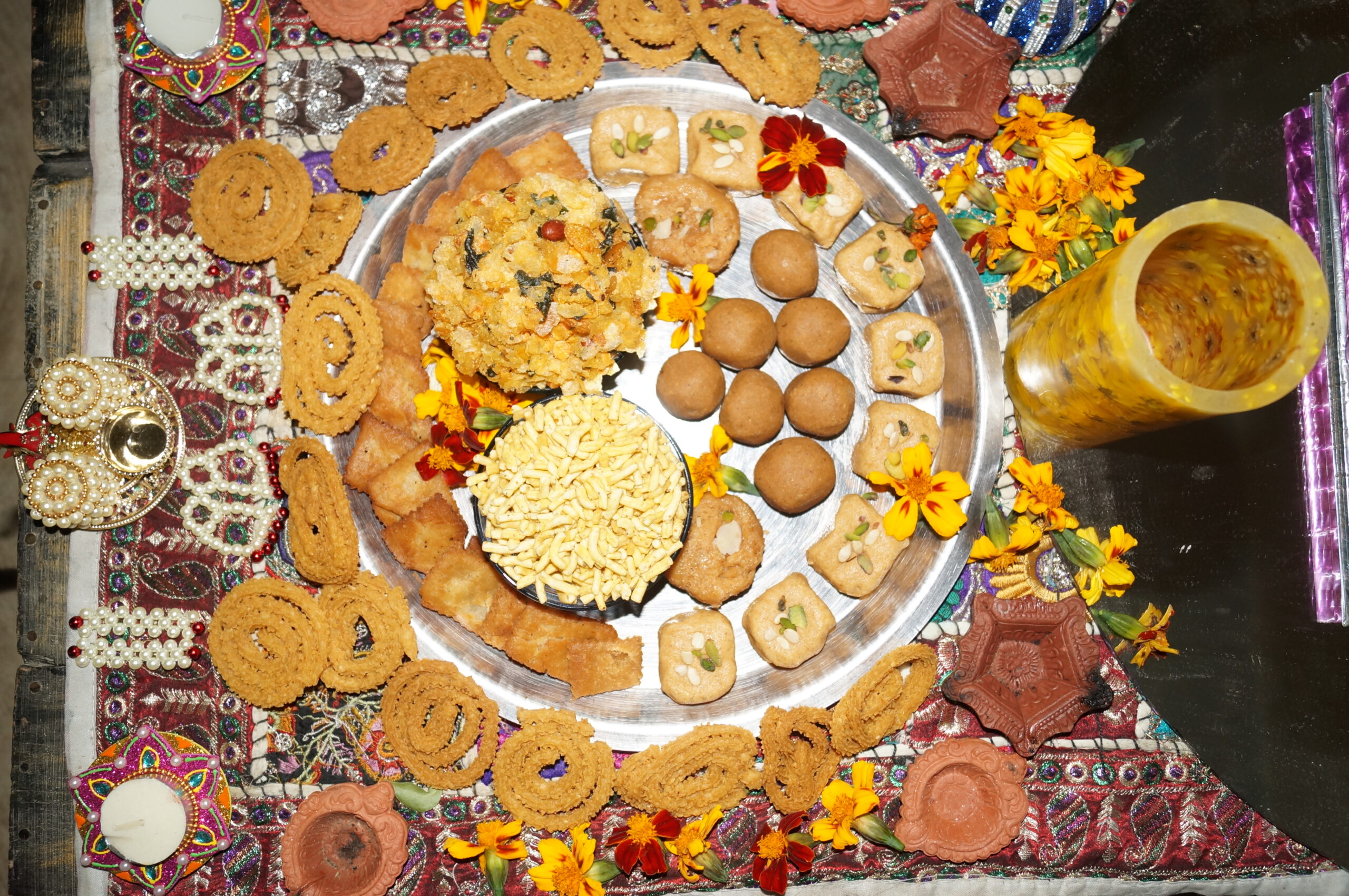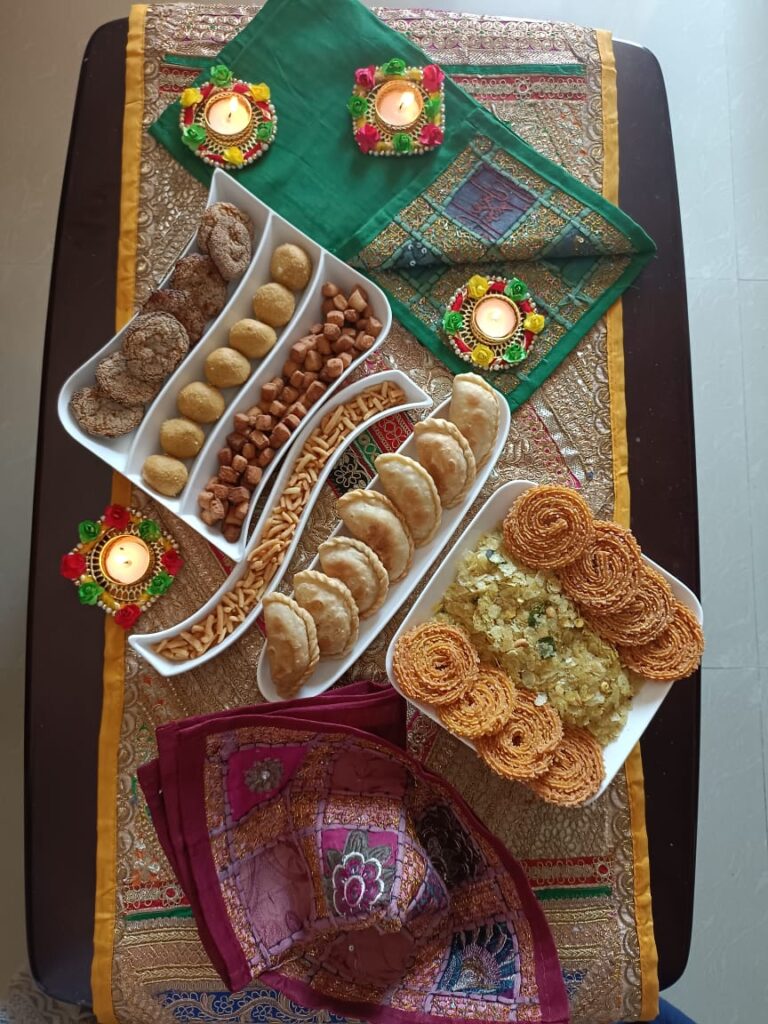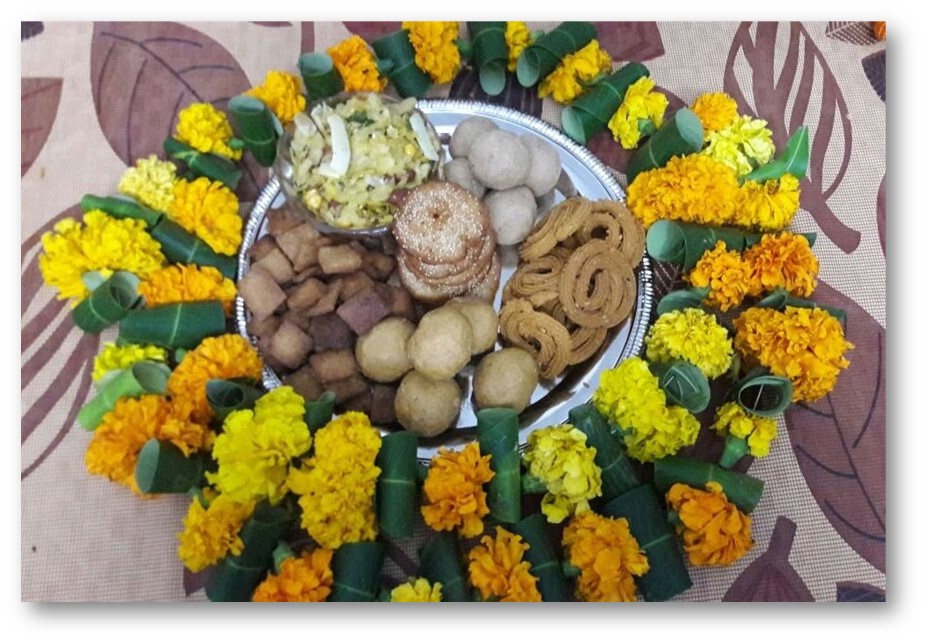Diwali, the festival of lights, brings with it an abundance of joy, family gatherings, and, of course, the irresistible aroma of freshly prepared sweets and snacks. In Maharashtrian homes, the preparation of Diwali Faral—a variety of traditional homemade sweets and namkeens (savory snacks)—is an integral part of the celebration. This ritual not only ties us to our cultural roots but also promotes a more sustainable and healthy way of celebrating the festival.

What is Diwali Faral?
In Maharashtra, Diwali Faral is a collection of sweets and savory snacks made at home, specifically for the festival. Families come together to prepare this diverse platter, which includes a range of items that are enjoyed and shared with friends and neighbors. Some of the popular items in a Maharashtrian Diwali Faral include:
- Laddoos: Whether it’s besan laddoo or rava laddoo, these sweet balls of joy are an essential part of Diwali.
- Chakli: Crisp and spiral-shaped, chakli is a savory snack made with rice flour, lentils, and spices.
- Anarse: A sweet delicacy made from rice flour and jaggery, with a crispy exterior and soft interior.
- Shankarpale: These are crispy, diamond-shaped fried pieces of dough, slightly sweet and perfect for snacking.
- Karanji: Also known as gujiya, these sweet dumplings filled with coconut, sugar, and nuts are a festive favorite.
- Chivda: A spicy mixture made from flattened rice (poha), peanuts, dried coconut, and spices.
- Chirote: Light, flaky, and sugar-dusted, chirote is a delicately layered sweet that melts in the mouth.
- Shev: Thin, crispy strands made from gram flour, often added to mixtures or enjoyed on their own.
- Mathri: A savory, crispy snack made from flour, spices, and deep-fried until golden.
The Fun of Making Faral at Home
One of the most beautiful aspects of Diwali is the preparation of these traditional sweets and namkeens at home. This process is a labor of love that brings families together. Elders pass down secret recipes to the younger generation, and children often help in shaping laddoos or rolling out chaklis. This tradition not only deepens family bonds but also adds a personal touch to the festival. It’s a time to reconnect with the rich culinary heritage of Maharashtra, sharing stories and laughter while preparing the delectable treats.
Benefits of Homemade Faral: Healthy, Hygienic, and Nutritious
In today’s world, where store-bought, plastic-packed sweets often contain preservatives, artificial colors, and excessive sugar, preparing Diwali Faral at home is a healthier and more nutritious alternative:
- Hygiene and Freshness: When prepared at home, you have complete control over the quality and cleanliness of the ingredients. There are no unknown additives or processed components, ensuring that the food is fresh and safe for consumption.
- Nutritious Ingredients: Homemade sweets and snacks often use traditional ingredients like jaggery, ghee, sesame seeds, besan (gram flour), and whole grains, which are packed with nutrients. For example, besan laddoos are rich in protein, while shankarpale made with whole wheat flour can provide fiber.
- Customization: You can adjust the level of sweetness, spiciness, or oil content to suit the preferences and dietary needs of your family. This makes homemade faral a more wholesome option, compared to overly sugary or oily market-bought products.
- Economical: Preparing faral at home is much more cost-effective than buying ready-made sweets and snacks, especially for large families or for gifting.

Promoting Sustainability: A Plastic-Free Diwali
In addition to health benefits, making Diwali Faral at home is a sustainable choice. When you prepare your own sweets and snacks, you avoid the excess packaging, especially plastic, that comes with store-bought sweets. Commercial sweets are often packaged in non-recyclable plastic boxes or wrappers, contributing to environmental pollution. By embracing homemade faral, you can significantly reduce waste and promote a more eco-friendly celebration.
Instead of gifting plastic-packed sweets from stores, opt for gifting your homemade Diwali Faral. Use reusable containers, cloth bags, or beautiful steel dabbas to share your faral with neighbors, friends, and loved ones. This is a thoughtful, personalized, and environmentally conscious gesture that carries the true essence of Diwali—sharing joy, love, and prosperity in a sustainable way.
Healthy, Homemade Faral: A Return to Tradition
In today’s fast-paced world, where convenience often trumps tradition, making faral at home reminds us to slow down and appreciate the cultural practices passed down through generations. It’s a way to preserve our heritage, ensure healthier eating habits, and protect the environment. With homemade faral, you’re not only nourishing your family with love and care but also choosing an eco-friendly path by minimizing plastic waste and promoting sustainability.
Gifting Faral: A Thoughtful Tradition
One of the most cherished aspects of Diwali is the custom of sharing sweets and snacks with friends and neighbors. When you make faral at home, it becomes a heartfelt gift that shows the care and effort you put into the festival. Instead of giving store-bought sweets, gifting homemade faral adds a personal touch that resonates with warmth and tradition. Whether it’s a box of freshly made chakli or a selection of laddoos and karanji, this gesture strengthens bonds and spreads the festive cheer in a meaningful way.
Conclusion: Celebrate a Healthier and Greener Diwali
By preparing and sharing Diwali Faral at home, we not only uphold the beautiful traditions of Maharashtrian culture but also promote health, hygiene, and sustainability. Homemade faral brings families together, nourishes the body and soul, and helps in reducing plastic waste—making it a more meaningful and eco-friendly way to celebrate Diwali.
This Diwali, let’s savor the taste of homemade sweets and namkeens while cherishing the joy of sharing these treats with our loved ones. May the light of Diwali shine bright, guiding us toward a healthier, happier, and more sustainable future. Happy Diwali! 🌟✨

Thank you for joining Prachi The Tatwa Girl. 🌿Read on various panchtatwa topics by #TheTatwaGirl.
Agni – The Fire Tatwa – Under this element, I write about food. Inspired by the energy and life force of this element, I share special recipes and culinary creations.
Vayu – The Air Tatwa – In this element, I write about things around us, the cultures and festivals being celebrated. Traditions followed and mythology and beliefs of a particular place.
Aakash – The Sky Tatwa – Here, I write about my travel experiences. Here, I describe the infinite skies and towering mountain peaks I encounter during my journeys.
Jal – The Water Tatwa – Here, I express my inner emotions, just like the flowing and ever-moving water. This is a reflection of the continuous flow of my thoughts.
Prithvi – The Earth Tatwa – In the earth element, I focus on environmental issues and eco-friendly lifestyle solutions. This includes ways to live in harmony with our planet. In today’s world, sustainable development has become a necessity. Don’t miss the Green Tatwa Talks podcast, and explore eco-friendly, sustainable living practices from awesome Green warriors I have interviewed, who work towards protecting the environment and bringing about positive change.
Subscribe on LinkedIn and get EcoFriendly with Prachi.
Follow The Tatwa Girl
Check PragunTatwa Feed
Visit my nature stories feed on my Instagram Feed, For more Eco-Friendly content.
Did you hug a tree today? Check my Tree Love posts and learn more about the Trees around us.
Leave a Reply